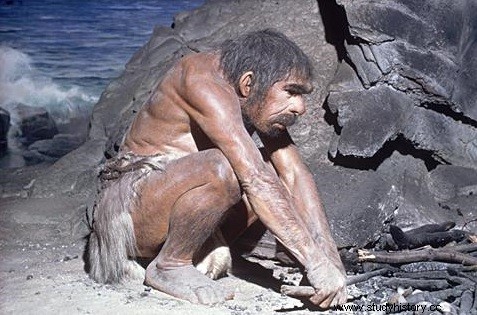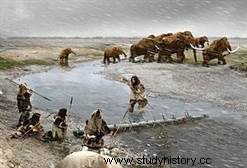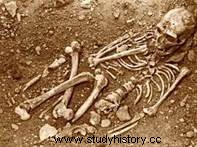 Neanderthal Man is a fossil man who lived in Europe and the Near East. It appeared about 200,000 years ago and lived until 30,000 years ago. Not very tall (1.60 meters), he is very robust. His body, stocky and muscular, is well adapted to the cold climate that reigned over Europe at that time. Very skilled at carving stone, Neanderthal man made a wide variety of weapons and tools. He is the first man to bury his dead with care, but we also know that he is willingly cannibalistic. It disappears a few thousand years after the arrival of homo-sapiens in Europe.
Neanderthal Man is a fossil man who lived in Europe and the Near East. It appeared about 200,000 years ago and lived until 30,000 years ago. Not very tall (1.60 meters), he is very robust. His body, stocky and muscular, is well adapted to the cold climate that reigned over Europe at that time. Very skilled at carving stone, Neanderthal man made a wide variety of weapons and tools. He is the first man to bury his dead with care, but we also know that he is willingly cannibalistic. It disappears a few thousand years after the arrival of homo-sapiens in Europe.
Portrait of Neanderthal Man
Neanderthals are a descendant of the first humans who arrived in Europe from the Near East 500,000 years ago. From this date, the settlement of Europe intensified and archaeological discoveries show that we are in the presence of the ancestor of Neanderthal Man. We thus speak of pre-Neanderthals from -500,000 to -300,000 years ago (like Tautavel Man for example). Neanderthal Man developed during a period which corresponds to the Middle Paleolithic and which extends from -300,000 to -35,000 years. Through the alternations between glacial and interglacial periods, it occupied practically all of Europe, as well as Iraq, Syria, Lebanon, Israel, Central Asia and Siberia.
 Overall, Neanderthal Man looks like us. He has a squarer build and stockier limbs. An adult measures 1.60 to 1.65 m and weighs 90 kg. The skull has its own characteristics. It is bulky and its cranial capacity is on average 1450 cm3 when that of modern humans is on average 1350 cm3. Seen from the front, his skull is broad, his nose is high and his cheekbones recede. The orbits are rounded and high. Seen in profile, he is elongated with a receding forehead, he has practically no chin. His teeth are bigger than ours.
Overall, Neanderthal Man looks like us. He has a squarer build and stockier limbs. An adult measures 1.60 to 1.65 m and weighs 90 kg. The skull has its own characteristics. It is bulky and its cranial capacity is on average 1450 cm3 when that of modern humans is on average 1350 cm3. Seen from the front, his skull is broad, his nose is high and his cheekbones recede. The orbits are rounded and high. Seen in profile, he is elongated with a receding forehead, he has practically no chin. His teeth are bigger than ours.
Natural environment
Neanderthal Man experienced many climatic fluctuations where very cold, glacial periods followed one another with temperate, interglacial periods, equivalent to our current climate. Thus, the fauna and flora have changed according to these fluctuations. During the glacial phases, the environment was steppe, open, and they rubbed shoulders with mammoths and woolly rhinos, reindeer, lions, bears and also hyenas. During the interglacial phases, the climate warmed up and they evolved in temperate forests with deer, deer, wild boar, aurochs, as well as lions and bears. The animal bones found by archaeologists on various French sites are a very good illustration of the species that Neanderthals lived alongside.
The hunting of mammoths by modern humans (homo sapiens), as well as the use of their bones for the construction of habitats (mainly in Russia and Ukraine) is proven for the Upper Palaeolithic. Could it be that this type of construction was invented by men before Homo Sapiens? Why not ! Well recently we think that Neanderthals may have been the first to make these constructions. Indeed, Neanderthal man has long been considered an archaic being compared to Homo Sapiens, but more and more recent studies are contradicting this reputation.
 A new Franco-Ukrainian study goes in this direction by trying to prove that not only the Neanderthal Man fed mammoths but also used their bones to make homes. The results of this study, carried out by Laëtitia Demay and Stéphane Péan, and coordinated by Marylène Patou-Mathis and Larissa Koulakovska1 have just been published in the journal Quaternary International. On the site of Moldova I located in the Dniester valley in Ukraine many remains have been discovered and studied.
A new Franco-Ukrainian study goes in this direction by trying to prove that not only the Neanderthal Man fed mammoths but also used their bones to make homes. The results of this study, carried out by Laëtitia Demay and Stéphane Péan, and coordinated by Marylène Patou-Mathis and Larissa Koulakovska1 have just been published in the journal Quaternary International. On the site of Moldova I located in the Dniester valley in Ukraine many remains have been discovered and studied.
This study is based on a level dating from the Middle Palaeolithic (-300,000 to approx. -35,000 years ago) which yielded 3,000 bones of mammals, in particular woolly mammoths and 40,000 Mousterian lithic remains. The various remains discovered make it possible to establish distinct activity areas such as a butchery area and a tool production area. 25 hearths and a circular accumulation composed of mammoth bones that could be a habitat structure were also unearthed at the site. Around this region, habitats are made of bone because wood is lacking. After an archaeozoological study of the bones of this structure, it can be said that the number of mammoths used is around 15 individuals. We can also say that according to the streaks present on the bones, the Neanderthals recovered the meat for food.
The circular mammoth bone structure looks like a windbreak shelter. It is not a covered dwelling like those of the Upper Paleolithic made by modern men. Inside we are in the presence of about fifteen hearths, lithic tools as well as butchery waste, characteristics of a domestic space.
The Neanderthals would therefore be the oldest Hominids to have used mammoth bones to build living structures. The presence of ocher on a certain number of bones even suggests a certain search for aesthetics (and/or symbolism?) in Neanderthals.
Neanderthal culture
Neanderthals lived in small groups according to the rhythms of the seasons, the movements of the herds and therefore frequently changed their habitat in a territory. He was nomadic. Archeology reveals traces of camping at the entrance to caves and on outdoor sites always near a water point. Its diet was mainly carnivorous but this did not prevent it from consuming shellfish, fish and berries. Like his predecessors, he made bifaces but above all developed tools on flakes with the so-called "Levallois" technique, which consists of preparing a block in order to obtain one or more flakes of predetermined shape whose cutting edge is very effective. .
The tools could be used for different tasks. For example, the scraper (a characteristic Neanderthal tool) could be used to scrape skins, work wood or cut meat. The use of fire by Neanderthals is attested by the remains of burnt bones and flint, and by a few rare traces of a hearth.
 Finally, their mode of dress is still not known to us. Having lived during very cold periods, they had to dress but nothing proves it to us. Animal skins are perishable and very rarely kept. We do know, however, that they had the appropriate tools (bone awls, drills and flint scrapers) and that some, like the scraper, had traces of wear showing the working of the skin. As well as traces of flint tools on bones very poor in nutrient material which seems to indicate a recovery of the skin.
Finally, their mode of dress is still not known to us. Having lived during very cold periods, they had to dress but nothing proves it to us. Animal skins are perishable and very rarely kept. We do know, however, that they had the appropriate tools (bone awls, drills and flint scrapers) and that some, like the scraper, had traces of wear showing the working of the skin. As well as traces of flint tools on bones very poor in nutrient material which seems to indicate a recovery of the skin.
The very large number of lithic remains presented in the showcases show us the different types of tools made and used by Neanderthals, as well as the various raw materials used. In addition, three videos show us the manufacture of three tools of this Neanderthal culture:the Mousterian scraper, the Levallois flake and the denticulate, while specifying for each what they could be used for.
Symbolic behaviors
Neanderthals buried their dead. They laid out the first known burials in the Near East around 100,000 years ago. Such practices can attest to the attention paid to the deceased and the concern to protect them from scavenger animals. To date, about forty burials have been discovered and always in a context of rock shelter habitat or in caves. The deceased are men, women, children and very rarely accompanied by grave goods.
Neanderthal skull casts are shown, such as that of a young boy discovered in Uzbekistan, another skull and an entire skeleton found in Israel, but also the foot of a skeleton found in Dordogne on the site of La Ferrassie as well as photographs of the Man from Chapelle-aux-Saints (Corrèze).  After having evoked the Neanderthal burials in the world, a zoom is made on those of the North-East of Aquitaine. It is in this region that a third of the known graves dated between -80,000 and -40,000 years are found. The four important sites discovered in the 19th century are presented:Le Moustier, La Ferrassie, Combe-Grenal and Pech de l'Azé.
After having evoked the Neanderthal burials in the world, a zoom is made on those of the North-East of Aquitaine. It is in this region that a third of the known graves dated between -80,000 and -40,000 years are found. The four important sites discovered in the 19th century are presented:Le Moustier, La Ferrassie, Combe-Grenal and Pech de l'Azé.
The disappearance of Neanderthals
Between -50,000 and -30,000 years ago, the disappearance of Neanderthals occurred, the arrival of modern humans in Europe as well as cultural changes that show the entered the Upper Paleolithic period. A few decades ago, one of the hypotheses put forward as to the disappearance of Neanderthals was linked to the arrival of Homo sapiens. It wouldn't be a coincidence.
Currently, no trace of "war" could be found on the archaeological sites. Then, a less good adaptation to the climatic conditions of the last glaciation is also advanced but rejected because previously the life of Neanderthals was punctuated by climatic variations with very cold periods.
Other hypotheses have been put forward but to this day the disappearance of Neanderthals remains an enigma. A beginning of an answer could be found thanks to recent studies on DNA.
To go further
- Neanderthals. Wandering, 2004.
- Neanderthal, my brother:300,000 years of human history. Flammarion, 2019.
